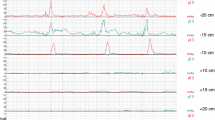Abstract
In four dogs we quantified the role of external (“coloileal”) ligaments in preventing coloileal reflux. All animals were tested under control conditions, and then two had all external ligamentous attachments between ileum and colon divided; the other pair underwent a sham operation. Coloileal reflux was quantified scintigraphically at colonic pressures of 20, 40, and 60 mm Hg, and ileal motility was recorded concurrently. During control experiments and after sham operations, no dogs showed coloileal reflux at colonic pressures of 20 and 40 mm Hg. At a colonic pressure of 60 mm Hg, two control experiments and one in a dog after sham operation resulted in reflux of 9%, 4%, and 8% of counts, respectively. In contrast, both test dogs (after division of the ligaments) refluxed 30–70% of colonic content in all of four experiments at pressure below 20 mm Hg. In control dogs and in those with a continent ileocolonic junction, ileal motility consisted of scattered clusters of phasic contractions. In dogs with coloileal reflux, these clusters occurred with a similar frequency, but they lasted longer (P <0.005). Four weeks later, ileal motility indices in control dogs were significantly less (P <0.02) than in animals with divided coloileal ligaments. These observations establish an experimental model for coloileal reflux, support the hypothesis that external ligamentous attachments help maintain continence at the ileocolonic junction, and imply that coloileal reflux changes the motor pattern of the terminal ileum.
Similar content being viewed by others
References
Bauhin A: Theatrum Anatomicum, 1605; quoted by Rosenberg JC, DiDio LJA: Dis Colon Rectum 13:220–224, 1970
Kellog JH: Surgery of the ileocecal valve: A method of repairing an incompetent ileocecal valve and a method of constructing an artificial ileocecal valve. Surg Gynecol Obstet 17:563–576, 1913
Cole LA: Ileocecal incompetency. Med Clin North Am 1:689–701, 1917
Richardson JD, Griffen WO: Ileocecal valve substitutes as bacteriologic barriers. Am J Surg 123:149–153, 1972
Myrvold H, Tindel MS, Isenberg HD, Stein TA, Scherer J, Wise L: The nipple valve as a sphincter substitute for the ileocecal valve: Prevention of bacterial overgrowth in the small bowel. Surgery 96:42–47, 1984
O'Reilly K: Ileal reversal to compensate for the loss of the ileocecal valve. Med J Aust 1:805–806, 1971
Buirge RE: Experimental observations on the human ileocecal valve. Surgery 16:356–369, 1944
Kelley ML, Gordon EA, DeWeese JA: Pressure studies of the ileocolonic junctional zone of dogs. Am J Physiol 209:333–339, 1965
Cohen S, Harris LD, Levitan R: Manometric characteristics of the human ileocecal junctional zone. Gastroenterology 54:72–75, 1968
Conklin JL, Christensen J: Local specialization at ileocecal junction of the cat and opossum. Am J Physiol 228:1075–1081, 1975
Quigley EMM, Phillips SF, Cranley B, Taylor BM, Dent J: Tone of canine ileocolonic junction: Topography and response to phasic contractions. Am J Physiol 239:G350-G357, 1985
Borody TJ, Quigley EMM, Phillips SF, Wienbeck M, Tucker RL, Haddad A, Zinsmeister, AR: Effects of morphine and atropine on motility and transit in the human ileum. Gastroenterology 89:562–570, 1985
Nasmith DG, Williams NS: Pressure characteristics of the human ileocecal region: A key to its function. Gastroenterology 89:345–351, 1985
Kumar D, Phillips SF: Reflux across the ileocecal junction: Role of superior and inferior ileocecal ligaments. Gastroenterology 91:59, 1986 (abstract)
Kumar D, Phillips SF: The contribution of external ligamentous attachments to function of the ileocecal junction. Dis Colon Rectum 30:410–416, 1987
Kellow JE, Miller LJ, Phillips SF, Haddad AC, Zinsmeister AR, Charboneau, JW: Sensitivities of human jejunum, ileum, proximal colon, and gallbladder to cholecystokinin octapeptide. Am J Physiol 252:G345-G356, 1987
Kamath PS, Hoepfner MT, Phillips SF: Short chain fatty acids stimulate motility of the canine ileum. Am J Physiol (in press)
Vantrappen G, Janssens J, Coremans G, Jian R: Gastrointestinal motility. Dig Dis Sci 31:55–255, 1986
Kelley ML, Gordon EA, Deweese JA: Pressure responses of canine ileocolonic junctional zone to intestinal distention. Am J Physiol 211:614–618, 1966
Kelley ML, Deweese JA: Effects of eating and intraluminal filling on ileo-colonic junctional zone pressure. Am J Physiol 216:1491–1495, 1969
Adkins P: The esophagogastric junction. J Surg Res 6:540–547, 1966
Marchand P: The gastroesophageal “sphincter” and the mechanism of regurgitation. Br J Surg 42:504–513, 1955
Author information
Authors and Affiliations
Rights and permissions
About this article
Cite this article
Kumar, D., Phillips, S.F. & Brown, M.L. Reflux from ileum to colon in the dog. Digest Dis Sci 33, 345–352 (1988). https://doi.org/10.1007/BF01535761
Issue Date:
DOI: https://doi.org/10.1007/BF01535761




